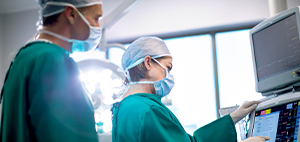From screenings that gauge your overall cardiovascular health, to tests that target specific conditions, our cardiovascular team is ready to assess and help improve your heart health. Learn more about available tests below.
Cardiovascular screening
Trust our experts to assess your overall cardiovascular health by signing up for one of our low-cost, preventive health screenings! For $100* this test includes screening for abdominal aortic aneurysm (AAA), carotid artery disease, atrial fibrillation, and peripheral artery disease (PAD).
Each half hour appointment will provide screenings for the most life-threatening vascular diseases. Appointments are necessary. Call our Heart Health Care team at (207) 351-2424 for more information.
*These screenings may not be covered by Medicare or other insurance companies. Please check with your carrier for details.
Other available tests
A test that uses ultrasound to detect peripheral vascular disease. This test uses doppler in conjunction with a series of arm and leg blood pressure cuffs to measure blood flow in the limbs. This test is most commonly used to determine if leg pain is the result of poor circulation in the legs (claudication). Because these tests use ultrasound and not x-rays, they are completely safe. These procedures do not require any preparation.
A medical procedure that uses quick, low-energy shocks to restore a regular heart rhythm. It's a treatment for certain types of irregular heartbeats (arrhythmias), including atrial fibrillation (A-fib). Sometimes cardioversion is done using medications.
This test is usually called an Echo. It uses sound waves (ultrasound) to produce a moving, two-dimensional image of the patient’s beating heart on a video screen. It’s a painless procedure that does not use x-rays and is completely safe. The physician can study the heart’s size and function, the motion and structure of the four heart valves and measure the direction and speed of blood flow. The test takes approximately 45 to 60 minutes to perform. No preparation is required.
An EKG is a graphic display of the electrical activity of the heart from electrodes placed on the skin in specific locations. The electrical activity created by the patient’s heart is processed by the EKG machine and then printed on special graph paper, which is later interpreted by a physician. This is a painless process that requires no preparation and takes approximately 10-15 minutes to perform.
It is not uncommon for patients to have symptoms that occur infrequently and are not documented by a 24-hour Holter monitor. This test is similar to a Holter monitor except it is meant to be worn for several days. Instead of the entire 24 hours of EKG information being stored, the event recorder stores or “loops” only the last 40-60 seconds of EKG continuously until a patient has symptoms. The patient then pushes a button on the recorder that “freezes” the current 40-60 seconds stored in memory and then records an additional 15-20 seconds of EKG. The recorder then locks this information in its memory and goes back to the “loop” mode to wait for the button to be pressed again if there is another event.
Typically, five events can be saved in the recorder. The event can be transmitted by phone to Cardiology to allow us to look at what has been recorded. The recorder is then reset and ready to record additional events if needed. Patients are shown how to connect themselves to allow them to sleep and bathe. The recorders are usually kept for 1-2 weeks.
A continuous, 24-hour electrocardiographic (EKG) recording of the heart’s rhythm to determine if rhythm disturbances are present and whether or not they need to be treated. This test is done most commonly for one of three reasons: a patient feels one or more disturbance, such as palpitations (ectopy) or rapid heart rate (tachycardia); a patient is having symptoms like dizziness or fainting that may be due to tachycardia and/or bradycardia (slow heart rate); or to determine if a patient’s pacemaker or defibrillator is working properly.
A portable digital recorder about the size of a deck of cards is connected via five adhesive electrodes to the patient’s chest. This device records every heartbeat over the 24-hour period it is worn. When it’s returned, the information is scanned by special computer software. A diary is given to the patient to document daily activity to allow symptoms and activities to be correlated with the recording.
A minor procedure where your cardiologist places a small device under your skin, on your check wall, overlying the heart. The machine works as an electrocardiogram (ECG), continuously picking up electrical signals from your heart.
A stress echo is a non-invasive test that combines two tests: a treadmill test and an echocardiogram (EKG). This test is used in situations where it’s known that the patient’s EKG will not be able to provide adequate diagnostic information or the physician suspects that a previous stress test was a false positive. The addition of the EKG helps improve the accuracy of the test by providing additional mechanical information about the heart during exercise. Echo images are taken before and immediately after exercise. These images are then interpreted along with the EKG at the end of the test.
A minimally invasive echocardiogram that offers very clear images of the heart’s structures and valves, without the interference of the chest wall and lungs. This procedure requires that a probe be passed down the esophagus, much like a gastroscope, except it uses ultrasound instead of a light source and camera. Total time for the test is about one hour. A patient needs to fast after midnight. The time that the probe is in the body is typically about 10 to 15 minutes. An IV is started to administer sedation to make the patient comfortable during the procedure. If the test is performed as an outpatient procedure, the patient needs to arrange for transportation home.
This test evaluates the heart’s response to exercise using a treadmill. It is used primarily to determine if a patient has coronary artery disease. The heart’s electrical activity is continuously monitored using an electrocardiogram (EKG). The treadmill exercise portion of the test is staged. The treadmill starts at a very slow walking pace and at a slight uphill grade. Every three minutes the speed and grade are increased.
During the exercise portion of the test, a physician is present. The goal of the test is to achieve an age adjusted target heart rate to make the test statistically reliable. The physician will discuss the results of the test with the patient immediately afterward. The complete procedure takes 30-45 minutes, with the exercise portion typically lasting 6-12 minutes. Depending on the reason for the treadmill, some medications should not be taken before the test. It is important to discuss this with your physician prior to the day of the test.
This is a painless technique using ultrasound for visualizing arteries and veins. It’s a generic term that includes tests such as carotid ultrasound, venous ultrasound, and arterial ultrasound. These procedures are sometimes referred to as duplex vascular ultrasound because the information is typically displayed in two different ways.
One is an image that displays the cross-sectional anatomy of the blood vessel being studied. It’s what is typically thought of as an ultrasound image (like the baby pictures of a pregnancy). The other is what is called doppler. This is a two-dimensional visual display of the speed and direction of blood flow within a vessel, similar to doppler weather maps that display cloud movements overlaid on a map. Doppler allows us to determine if blood flow has slowed, reversed, or stopped in a blood vessel because of disease and accurately measure the severity of the disease.




